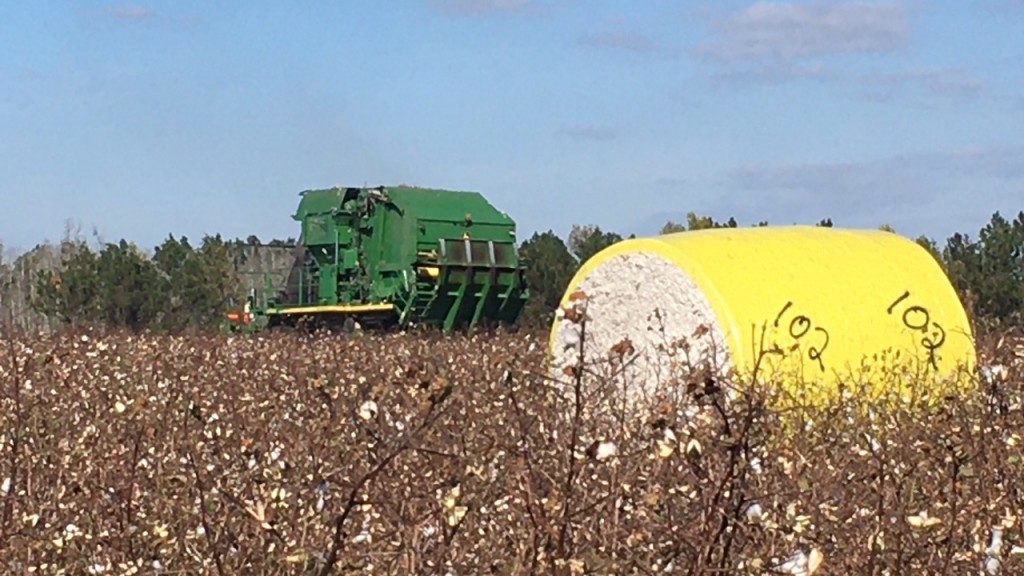Corn harvest is gearing up. I have been hearing good yields so far from corn growers. The weather this week should be good for harvest. The cotton crop has challenges such as boll rot, cotton jassid and mildew. Questions about leaf spot and white mold have been coming in from peanut growers. Rainfall last week was variable in the county which is shown below.
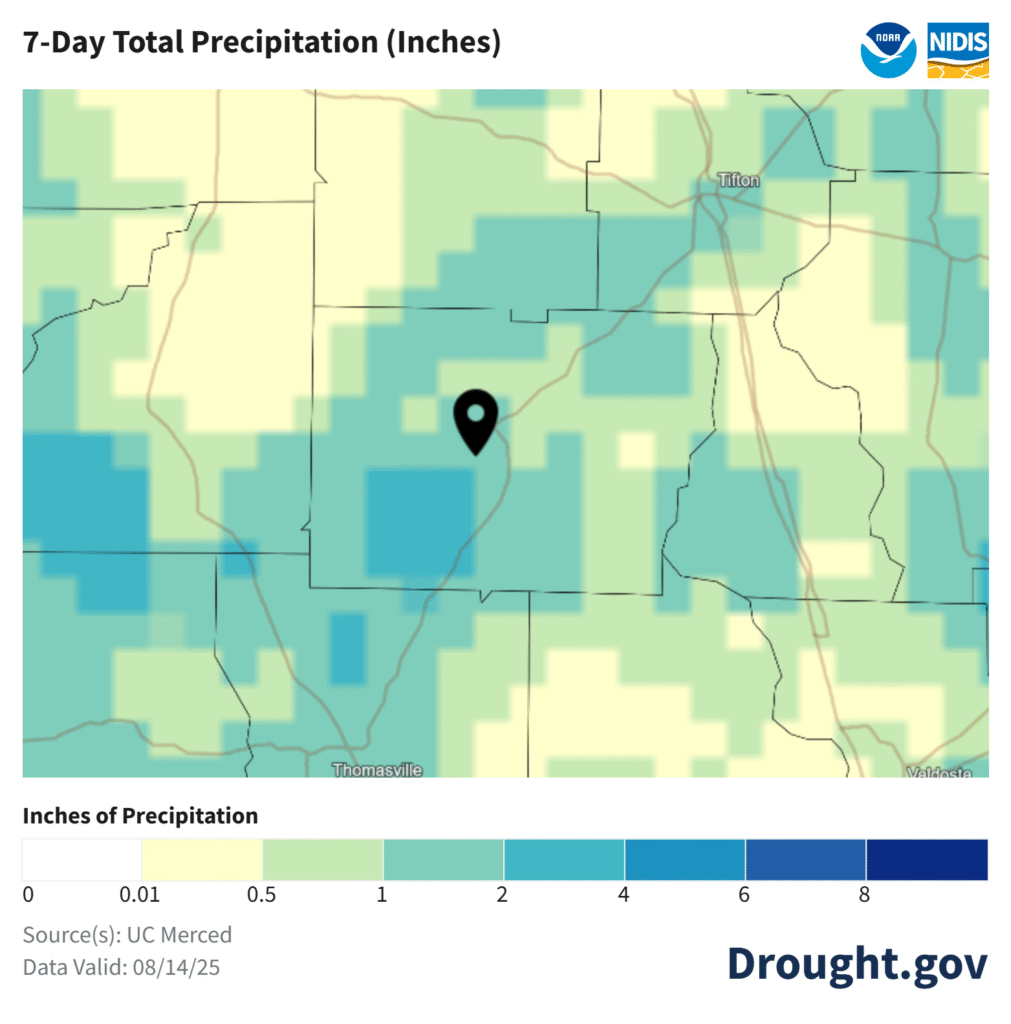
Peanuts: I have been seeing a few more caterpillars, such as velvet bean caterpillar, corn ear worm and soybean looper, in peanuts this past week but they have been below threshold. Early and late leaf spot have been building in some fields and can be worse in fields with tighter rotations.
In the UGA Peanut Production The 2024 Pest Management Quick Reference Guide, it mentions that if you would like to include systemic activity, chlorothalonil (1.5 pt) on a 14-day spray interval can be replaced with products such as with:
- Chlorothalonil, 1.0 pt + Alto, 5.5 fl oz (Note PHI for Alto is 30 days)
- Chlorothalonil, 1.0 pt + thiophanate methyl, 5 fl oz (no more than two
applications) - Chlorothalonil, 1.0 pt + Domark 230ME, 2.5 fl oz
- Chlorothalonil, 1.0 pt + Provysol, 3 fl oz/A
- Andiamo Advance (Mazinga ADV) (32 fl oz/A)
- Thiophanate methyl, 10 fl oz (no more than one application)
- Aproach Prima, 6.8 fl oz (best used earlier in season). If applied later
in the season consider mixing with sulfur or chlorothalonil. - Priaxor, 4 fl oz (or 6 fl oz replaces two early applications. Priaxor at 8
fl oz/A provides leaf spot and white mold control) - Absolute MAXX, 3.4 fl oz (early season use only). If applied later in the
season, consider a tank mix with chlorothalonil. - Tebuconazole, 7.2 fl oz + chlorothalonil, 1.0 pt (replaces 1.5 pt
chlorothalonil and fights white mold) - Provysol (3-5 fl oz/A) likely tank-mixed with EXCALIA, Convoy, or
tebuconazole.
Older products that can be used for leaf spot control (sometimes mixed
with chlorothalonil include sulfur (e.g. Microthiol Microthiol Disperss,
5lb/A) and mancozeb (Koverall)
NOTE 2:
Microthiol 80 WDG or Microthiol Disperss may be tank mixed at 3-5 lbs. per acre with FRAC 3,7, 11 fungicides or combinations of those.
Topsin 4.5 FL, 10 ounces per acre as tank mix with Manzate Pro-Stick
or Penncozeb 75 DF at 1.5 lbs. per acre in either the 105 or 120 DAP
applications.
Tanner reported his whitefly captures for this past week. The data shows an increase in whitefly populations at all seven locations. If you would like to look at other locations where county agents are monitoring sticky traps please go here.
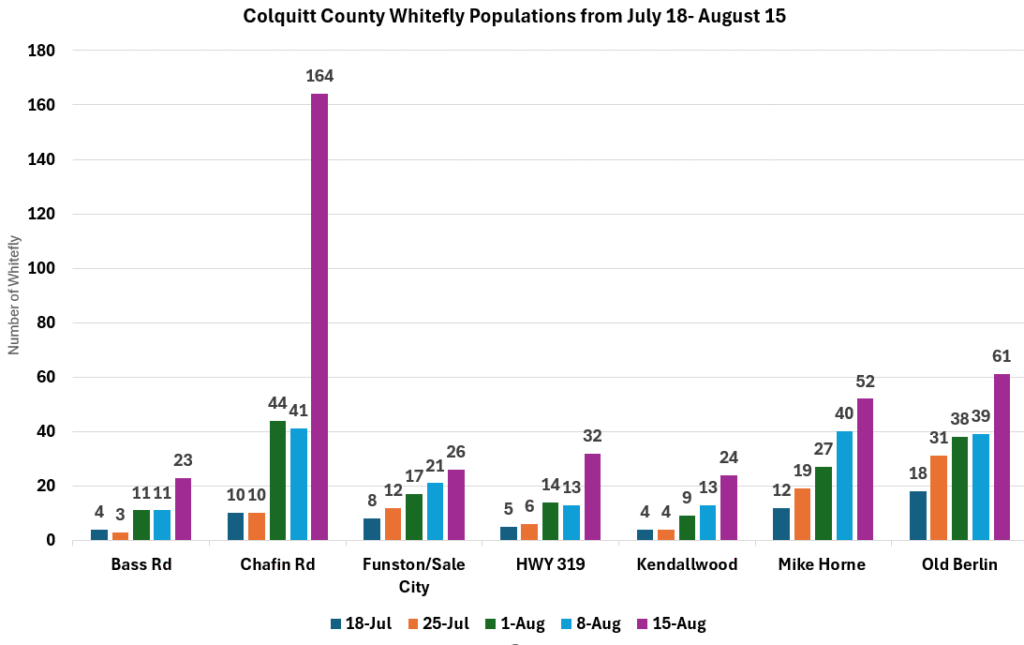
August is a tough month to look at cotton. Boll rot has been common in fields. The picture below is an example of Diplodia Boll Rot. Note the black and sooty spores on hand. Boll rots are caused by a complex of fungal and bacterial pathogens. Boll rot is unavoidable if cotton is subjected to prolonged periods of wetness and humidity late in the growing season. In Georgia, this can happen if a tropical storm or hurricane causes excessive rainfall, especially over a several-day period. In such situations, there is little a farmer can do to minimize losses to boll rots.

The talk of the town is all about the cotton jassid. Preliminary insecticide trials in Georgia indicate that pyrethroids such as bifenthrin alone do not provide acceptable control. The table below shows results from a strip trial conducted in Colquitt County. Treatments were applied on August 6, 2025 with a grower sprayer and rated at 5 days after treatment (DAT). Dr Phillip Roberts, UGA Cotton Entomologist, helped with the data collection. Treatments included Imidacloprid, Bidrin and Knack. Knack does show some promise, but this is one strip trial. We will rate this trial again this week.

Last Thursday (August 14, 2025) Dr. Roberts brought down the jassid sprayer to evaluate several insecticides on their efficacy on cotton jassid. Treatments include Assail, Bidrin, bifen, Centric, Courier, Knack, Sefina and Transform. Hopefully we will collect some data this week for local growers.

When to Terminate Cotton Irrigation (Dr Wes Porter)
According to Dr. Porter, the official UGA recommendation (2024 Georgia Cotton Production Guide | UGA Cooperative Extension) for irrigation termination is to terminate irrigation at 10% open boll—typically when 1–3 bolls are visibly cracked. Continuing irrigation beyond this point can lead to:
- Boll rot
- Hard lock
- Increased unnecessary leaf wetness periods
- Increased disease pressure due to fall humidity and rainfall
Before Deciding to Terminate Irrigation:
- Scout the field and check the current cotton physiological stage and track accordingly, when the stage has reached physiological cutout or 3 nodes above white flower, decisions about irrigation termination should start to be considered.
- Check soil moisture in the field and make an estimation on current status and how long it will be until the crop reaches 10% open boll. The profile needs to be full at 10% open boll to finish off for the season.
- Consider near-term weather forecasts .
- Do your best to reduce the leaf wetness period, nighttime dew will already puts moisture on the leaves, if possible, do not continue to stretch this period with irrigation. In most cases, this is not possible due to irrigation application constraints.
- If moisture is determined to be present and adequate or rain is expected and guaranteed, irrigation can be safely terminated.
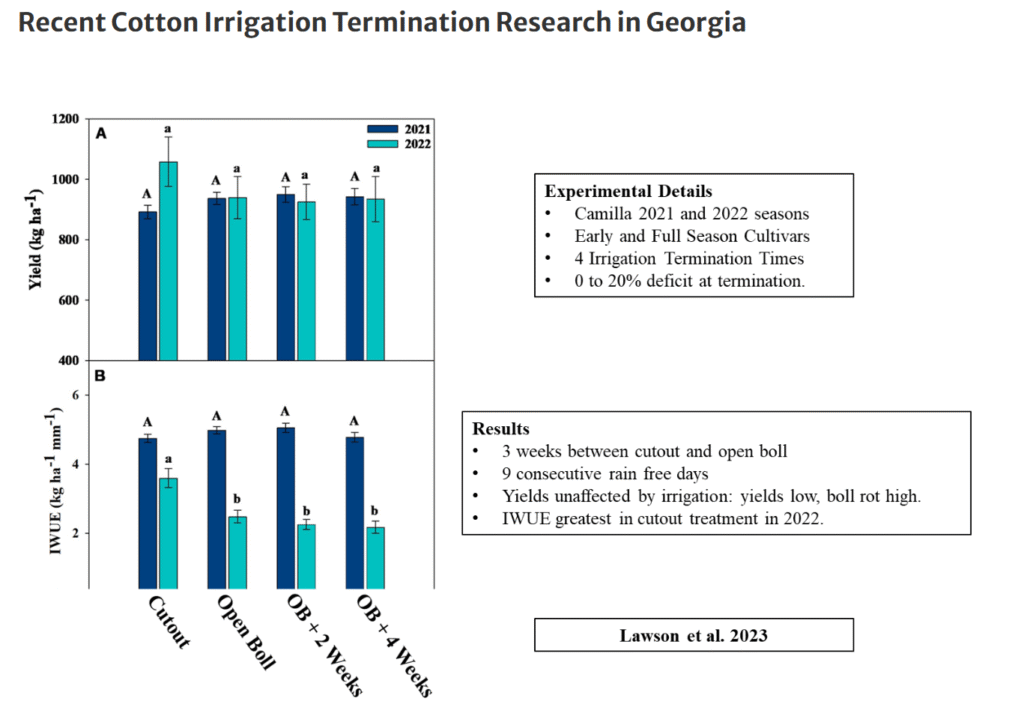
In a two-year study by Lawson et al. 2023, four irrigation termination dates were evaluated, which were Cutout, Open Boll, Open Boll + 2 Weeks (OB+2), and Open Boll + 4 Weeks (OB+4). Overall, as shown in the graphs above, there were significant difference between years for yield, but not for yield within each year. However, there were significant differences for Irrigation Water Use Efficiency (IWUE). This is very important, because it shows that there was no effect, positive or negative, for continued irrigation after cutout, but there were savings in irrigation water.
The table below shows the result of the study from the economic perspective. I used the previously mentioned irrigation cost data to calculate the cost of additional irrigation applications at the end of the season. Remember, there were not significant differences in yield, so I did not consider lint yield profit differences in this calculation, only irrigation.
During 2021, there was sufficient rainfall, such that only one additional irrigation application of 0.4 inches applied to the OB+4 Weeks treatment. As shown, this additional irrigation cost $3.20 and $6.40 per acre respectively. However, during 2022, the fall was much drier, and each treatment required additional irrigation. As shown in the table, the OB treatment costs an additional $26.40 and $52.80 for electric and diesel respectively and the additional cost only went up from there for irrigating beyond cutout.
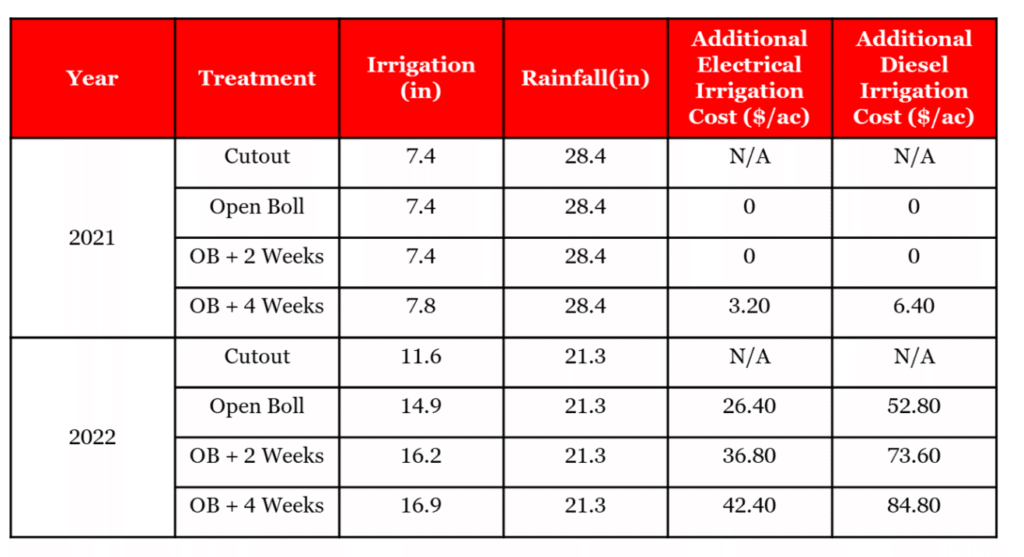
An additional study was started during 2024 to determine effects of terminating irrigation at open boll and at cutout. 2024 was the first year of this study and data for 2025 are not yet available. Similar to the previous study there were no significant differences between the two irrigation termination treatments, but there were significant differences in the IWUE’s. During 2024 $12 to $24 dollars per acre were saved for the two irrigation events that were not applied to the cutout treatment.
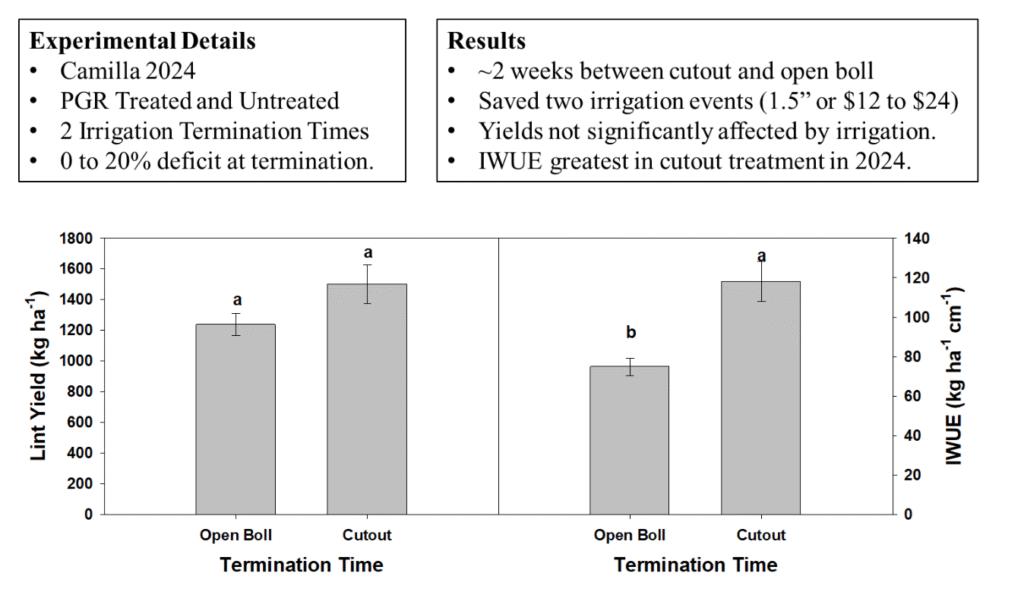
Thus, while we do not have enough site years of data to make a hard recommendation to terminate irrigation at the cutout time, frame data are showing that if adequate moisture is available during this stage, there are no yield penalties for terminating irrigation and there is no yield gained for irrigating beyond this point.
With this stated, I strongly encourage growers to consider terminating irrigation no later than 10% open boll and earlier if they have adequate soil moisture and are confident in their current situation.
Irrigation termination in cotton can be a tricky and potentially costly decision. I urge you to scout your fields, monitor soil moisture, plant physiological stage, weather predictions and conditions, and make a final decision when best fits your field and situation. For support on these decisions feel free to reach out to your local UGA County Extension Agent.
Have a safe week and if you have questions please call the office,
Jeremy M. Kichler
Colquitt County Extension Coordinator
The University of Georgia Cooperative Extension does not endorse or guarantee the performance of any products mentioned in this update.
